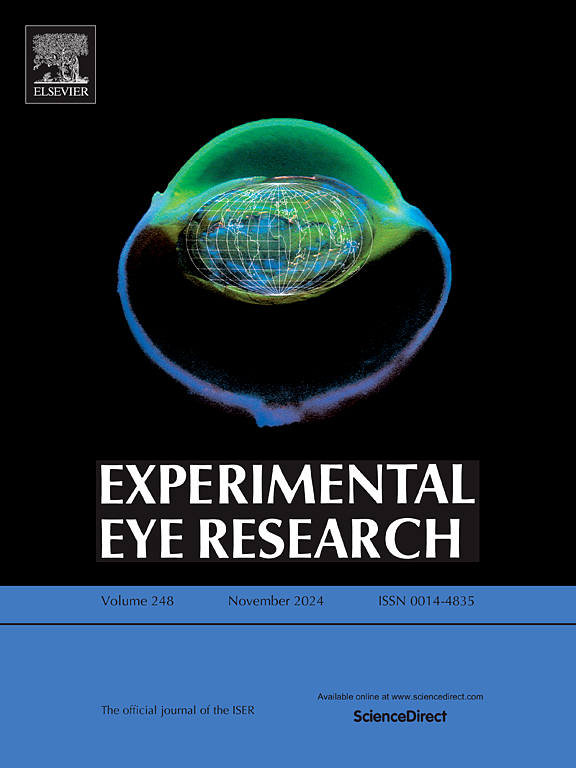整合素αvβ6介导年龄相关性基质硬度降低对青光眼Tenon成纤维细胞活化和水泡瘢痕形成的影响。
IF 2.7
2区 医学
Q1 OPHTHALMOLOGY
引用次数: 0
摘要
青光眼包括原发性开角型青光眼(POAG)和原发性闭角型青光眼,可导致视神经损伤和视野丧失,通常需要手术干预以降低眼压(IOP)。小梁切除术,最常见的青光眼手术,可能由于滤过泡过度瘢痕形成而失败,这是由人类Tenon纤维母细胞(HTFs)的过度增殖所驱动的。本文研究老化对Tenon’s capsule组织基质刚度的影响,细胞外基质(extracellular matrix, ECM)刚度在HTFs表型转化中的作用,以及整合素α - β6 (integrin alphavbeta6, αv - β6)的调控功能。老年性青光眼患者的Tenon’s capsule组织基质硬度明显低于年轻患者,α-SMA、胶原I和整合素αvβ6水平降低。建立青光眼滤过手术(Glaucoma Filtration Surgery, GFS)模型,观察老年SD大鼠ECM僵硬度降低,纤维化减少,整合素αvβ6表达降低。老年青光眼患者HTFs表现出ECM僵硬度降低、活力降低、迁移受损和纤维化反应减弱。当年轻青光眼患者HTFs在不同硬度的底物上培养时,发现更硬的底物增加了细胞活力、迁移、胶原合成和纤维化标志物的表达。此外,在较硬的基质上培养的HTFs中,敲低整合素αvβ6会导致细胞活力下降,迁移受损,胶原合成减少,纤维化标志物表达降低。体内敲低整合素αvβ6可有效降低ECM硬度和纤维化,从而减轻幼龄大鼠GFS后的水泡瘢痕。总之,衰老相关的ECM硬度和整合素αvβ6表达的变化有助于减少纤维化,可能提高老年患者小梁切除术的成功率。本文章由计算机程序翻译,如有差异,请以英文原文为准。
Integrin αvβ6 mediates the effects of age-related decreases in matrix stiffness on Tenon's fibroblast activation and bleb scarring in glaucoma
Glaucoma, including primary open-angle glaucoma (POAG) and primary angle-closure glaucoma, leads to optic nerve injury and visual field loss, often necessitating surgical intervention to lower intraocular pressure (IOP). Trabeculectomy, the most common glaucoma surgery, could fail due to excessive scarring of the filtering bleb, driven by the hyperproliferation of human Tenon's fibroblasts (HTFs). Herein, the impact of aging on matrix stiffness in Tenon's capsule tissue, the role of extracellular matrix (ECM) stiffness in the phenotypic transformation of HTFs, and the regulatory function of integrin alphavbeta6 (αvβ6) were investigated. Matrix stiffness in Tenon's capsule tissue is notably lower in elder glaucoma patients in comparison with younger ones, with reduced levels of α-SMA, collagen I, and integrin αvβ6. GFS (Glaucoma Filtration Surgery) models were established in young and old SD rats, and it was observed that older rats exhibited lower ECM stiffness, reduced fibrosis, and decreased integrin αvβ6 expression. HTFs from elderly glaucoma patients showed reduced ECM stiffness, decreased viability, impaired migration, and diminished fibrotic responses. When HTFs from young glaucoma patients were cultured on substrates of varying stiffness, it was found that stiffer substrates increased cell viability, migration, collagen synthesis, and fibrosis marker expression. Additionally, knocking down integrin αvβ6 in HTFs cultured on stiffer substrates resulted in decreased cell viability, impaired migration, reduced collagen synthesis, and lower fibrosis marker expression. In vivo knockdown of integrin αvβ6 effectively reduced ECM stiffness and fibrosis, thereby attenuating bleb scarring after GFS in young rats. Collectively, the aging-associated changes in ECM stiffness and integrin αvβ6 expression contribute to reduced fibrosis, potentially enhancing the success of trabeculectomy in elder patients.
求助全文
通过发布文献求助,成功后即可免费获取论文全文。
去求助
来源期刊

Experimental eye research
医学-眼科学
CiteScore
6.80
自引率
5.90%
发文量
323
审稿时长
66 days
期刊介绍:
The primary goal of Experimental Eye Research is to publish original research papers on all aspects of experimental biology of the eye and ocular tissues that seek to define the mechanisms of normal function and/or disease. Studies of ocular tissues that encompass the disciplines of cell biology, developmental biology, genetics, molecular biology, physiology, biochemistry, biophysics, immunology or microbiology are most welcomed. Manuscripts that are purely clinical or in a surgical area of ophthalmology are not appropriate for submission to Experimental Eye Research and if received will be returned without review.
 求助内容:
求助内容: 应助结果提醒方式:
应助结果提醒方式:


